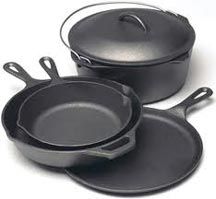Cast Iron - Considered the Best Cookware Around!
By Alice Osborne
 I was flipping through an old issue of Real Simple magazine and found the best article on cast iron cookware. I come from a family of cast iron believers and cookers, so I was delighted with the validation. Here's what the article said in a nutshell:
I was flipping through an old issue of Real Simple magazine and found the best article on cast iron cookware. I come from a family of cast iron believers and cookers, so I was delighted with the validation. Here's what the article said in a nutshell:
"Mom was right: Looks aren't everything. A homely cast-iron skillet may lack the sleek allure of more expensive cookware, but if you give it a chance, it will win you over with both its outward appeal (a durable nonstick surface) and its deeper qualities (remarkable heat retention, as well as the ability to impart a perfect crust to everything from a pork tenderloin to a raspberry tart). And with just a little TLC, it will take care of you for a lifetime."
The article went on to share some well-known advice for what the cast iron TLC is:
 While cast iron comes in all sizes and shapes, nothing is more versatile than a basic skillet. Either a 10- or 12-inch will do just fine.
While cast iron comes in all sizes and shapes, nothing is more versatile than a basic skillet. Either a 10- or 12-inch will do just fine.
There's only one thing you shouldn't attempt in cast-iron cookware: boiling water, which will cause the pan to rust every time.
Cast iron takes longer to warm than other surfaces but retains heat remarkably well and diffuses it evenly. So give it time to come up to temperature - patience, patience.
Cast iron remains hot long after you remove it from the stove. As a reminder to be careful, drape a thick towel or a mitt over the handle.
To avoid getting smudges on all your kitchen towels, designate one to use exclusively for drying your cast iron.
Seasoning: Traditional cast-iron skillets don't emerge from the box with a nonstick surface. That comes with "seasoning," which is coating the skillet with cooking oil and baking it in a 350 degrees F oven for an hour. It won't take on that shiny black patina just yet, but once you dry it with paper towels, it will be ready to use.
You'll reinforce the nonstick coating every time you heat oil in the skillet, and you can hasten the process by seasoning as often as you like. Or you can forget seasoning and go with Lodge Logic (available at hardware and cookware stores), a line of pre-seasoned skillets from Lodge Manufacturing, the oldest U.S. maker of cast-iron cookware.
 Cleaning: A cast-iron skillet isn't ideal for a set-aside-to-soak sort of person. For best results, rinse the pan with hot water immediately after cooking. If you need to remove burned-on food, scrub with a mild abrasive, like coarse salt, and a nonmetal brush to preserve the nonstick surface; you can also use a few drops of a mild dishwashing soap every once in a while.
Cleaning: A cast-iron skillet isn't ideal for a set-aside-to-soak sort of person. For best results, rinse the pan with hot water immediately after cooking. If you need to remove burned-on food, scrub with a mild abrasive, like coarse salt, and a nonmetal brush to preserve the nonstick surface; you can also use a few drops of a mild dishwashing soap every once in a while.
If the pan gets a sticky coating or develops rust over time, scrub it with steel wool and re-season it. To prevent rust, dry the skillet thoroughly and lightly coat the cooking surface with cooking oil. Cover with a paper towel to protect it from dust.
And now my own cleaning tip: I lay my dishrag out in the sink and set my cast iron on it before cleaning the pan. This prevents those annoying black marks the pan will leave after the scrubby-scrubby routine. This way there's no need to clean the pan AND the sink!
 Finally, an interesting fact: Cooking in cast iron increases the iron content of food. The longer the food is in contact with the skillet, the more it will absorb. Thus, this is one reason folks who struggle with anemia really like cooking in cast iron.
Finally, an interesting fact: Cooking in cast iron increases the iron content of food. The longer the food is in contact with the skillet, the more it will absorb. Thus, this is one reason folks who struggle with anemia really like cooking in cast iron.

